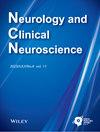Long‐term safety of oral edaravone in Japanese patients with amyotrophic lateral sclerosis: Sub‐analysis of a global, open‐label, phase 3 study
IF 0.4
Q4 CLINICAL NEUROLOGY
引用次数: 0
Abstract
Patients with amyotrophic lateral sclerosis (ALS) experience a slower rate of physical function decline when treated with intravenous edaravone. The oral suspension formulation of edaravone (105 mg) has a similar pharmacokinetic profile to intravenous edaravone (60 mg/60 min). The long‐term safety of oral edaravone in Japanese patients with ALS has not been reported. Therefore, a sub‐analysis of Japanese patients in a global phase 3 study (NCT04165824) was conducted to evaluate the safety and tolerability of oral edaravone in Japanese patients with ALS.This study was a global, open‐label, phase 3 study to evaluate the long‐term safety and tolerability of oral edaravone in patients with ALS. Patients with ALS received oral edaravone (105 mg/day) for 48 weeks. Adverse events in Japanese patients were assessed at week 48.Among the 185 patients enrolled globally, 65 patients were enrolled in Japan (mean age, 59.3 years; mean disease duration, 1.5 years). Most patients experienced treatment‐emergent adverse events (TEAEs) (84.6%), and the most common TEAEs by week 48 were constipation (15.4%), insomnia (12.3%), and back pain (10.8%). Two serious TEAEs were reported: atrial fibrillation and pleural effusion (both n = 1). Three adverse drug reactions (ADRs) were reported: diarrhea, abnormal hepatic function, and fatigue (all n = 1). There were no serious ADRs or TEAEs/ADRs that led to study drug discontinuation.Oral edaravone had a similar safety profile to intravenous edaravone in Japanese patients, and good tolerability over 48 weeks. No new safety concerns were observed in this population.日本肌萎缩性脊髓侧索硬化症患者口服依达拉奉的长期安全性:一项全球性开放标签 3 期研究的子分析
肌萎缩性脊髓侧索硬化症(ALS)患者在接受静脉注射依达拉奉治疗后,身体机能下降的速度会减慢。依达拉奉口服混悬剂(105 毫克)与静脉注射依达拉奉(60 毫克/60 分钟)具有相似的药代动力学特征。日本 ALS 患者口服依达拉奉的长期安全性尚未见报道。因此,我们对一项全球性 3 期研究(NCT04165824)中的日本患者进行了子分析,以评估日本 ALS 患者口服依达拉奉的安全性和耐受性。这项研究是一项全球性、开放标签的 3 期研究,旨在评估 ALS 患者口服依达拉奉的长期安全性和耐受性。ALS患者口服依达拉奉(105毫克/天)48周。在全球招募的185名患者中,日本招募了65名患者(平均年龄59.3岁;平均病程1.5年)。大多数患者出现了治疗突发不良事件(TEAEs)(84.6%),第48周时最常见的TEAEs是便秘(15.4%)、失眠(12.3%)和背痛(10.8%)。报告了两种严重的 TEAE:心房颤动和胸腔积液(均为 1 例)。报告了三种药物不良反应(ADRs):腹泻、肝功能异常和疲劳(均为 1 例)。在日本患者中,口服依达拉奉的安全性与静脉注射依达拉奉相似,48周的耐受性良好。在这一人群中未发现新的安全性问题。
本文章由计算机程序翻译,如有差异,请以英文原文为准。
求助全文
约1分钟内获得全文
求助全文

 求助内容:
求助内容: 应助结果提醒方式:
应助结果提醒方式:


